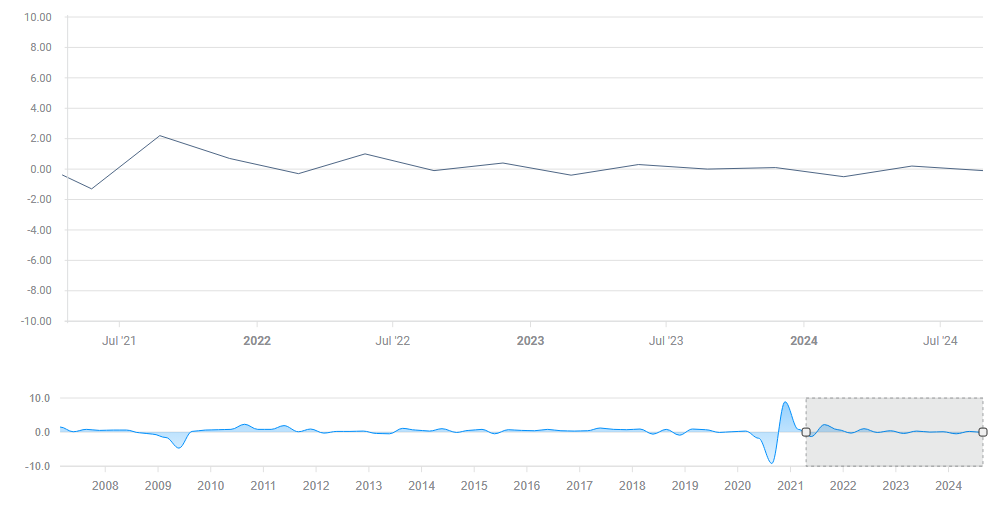- Initial German GDP data for Q3 is set to confirm another recession in Europe's largest economy.
- Eurozone GDP may also be dragged down by Germany’s subdued performance, showing that the drop in inflation is symptomatic of a worse outcome.
- The contrast with US solid growth may exacerbate pressure on EUR/USD.
The sick man of Europe – that not-so-flattering nickname to Germany's economy has resurfaced. It was first coined in the early 2000s, when the old continent's largest economy struggled with high unemployment, low productivity and ongoing struggles with reunification.
This time, Germany suffers from other issues – overreliance on Russian Gas, exports to China, and a struggling automotive industry. For the first time in its nine-decade history, Volkswagen is set to close three factories in its home country, and tens of thousands of workers will be laid off.
The economic calendar points that Germany faced a second consecutive quarter with negative growth – the common definition of a recession. This is not the first time that Germany would suffer a shrinking economy in the post-covid era. Times of expansion have proved limited.
German GDP. Source: FXStreet
A 0.1% drop in output, as economists expect, would weigh on the Euro (EUR), even if it would merely match expectations. Even a no-change figure would fail to inspire because barely avoiding an official recession is uninspiring and it doesn’t change the big picture of a struggling economy.
German data feeds into the 20-strong Eurozone output figures, which will be released shortly afterward on Wednesday. Economists expect a growth rate of 0.2%, driven by expectations of a 0.4% growth rate in France, the second- largest economy, 0.2% in Italy, the third, and 0.6% in Spain, the fourth.
While Germany is roughly only a quarter of the 20-strong Eurozone, its malaise gets attention and influences the Euro. The fight against inflation, directed by the European Central Bank's (ECB) headquarters in Frankfurt, seems to be over. Price rises have almost disappeared, and in large part due to meager growth.
EUR/USD has been on the back foot in recent weeks, owing to concerns that contrast the strength of the US economy. On the same day that German and Eurozone GDP data come out, officials in Washington also publish their first estimates for US growth, putting the two in sharp relief.
The US is expected to report an annualized growth rate of 3%, roughly equivalent to 0.7% QoQ expansion. That would beat projected results from Spain, the fastest-growing large Eurozone economy.
What if Germany reports surprising growth? A 0.1% expansion rate would not only imply no recession but also boost the Euro. However, I expect a limited upside for EUR/USD. Skeptics would see this as a temporary bump in a wider slowdown for the old continent.
All in all, I expect German and Eurozone GDP data to weigh on the Euro, either sooner or later.
Information on these pages contains forward-looking statements that involve risks and uncertainties. Markets and instruments profiled on this page are for informational purposes only and should not in any way come across as a recommendation to buy or sell in these assets. You should do your own thorough research before making any investment decisions. FXStreet does not in any way guarantee that this information is free from mistakes, errors, or material misstatements. It also does not guarantee that this information is of a timely nature. Investing in Open Markets involves a great deal of risk, including the loss of all or a portion of your investment, as well as emotional distress. All risks, losses and costs associated with investing, including total loss of principal, are your responsibility. The views and opinions expressed in this article are those of the authors and do not necessarily reflect the official policy or position of FXStreet nor its advertisers. The author will not be held responsible for information that is found at the end of links posted on this page.
If not otherwise explicitly mentioned in the body of the article, at the time of writing, the author has no position in any stock mentioned in this article and no business relationship with any company mentioned. The author has not received compensation for writing this article, other than from FXStreet.
FXStreet and the author do not provide personalized recommendations. The author makes no representations as to the accuracy, completeness, or suitability of this information. FXStreet and the author will not be liable for any errors, omissions or any losses, injuries or damages arising from this information and its display or use. Errors and omissions excepted.
The author and FXStreet are not registered investment advisors and nothing in this article is intended to be investment advice.
Recommended Content
Editors’ Picks

EUR/USD recovers toward 1.0500 after mixed US PMI data
EUR/USD rebounds toward 1.0500 in the American session on Friday after the data from the US showed that the business activity in the private sector expanded at a softer pace than anticipated in early February. The pair remains on track to end the week with little changed.

GBP/USD rises above 1.2650, looks to post weekly gains
GBP/USD regains its traction and trades above 1.2650 in the second half of the day on Friday. The data from the US showed that the S&P Global Services PMI dropped into the contraction territory below 50 in February, causing the US Dollar to lose strength and helping the pair edge higher.

Gold holds above $2,930 as US yields edge lower
Gold holds above $2,930 after correcting from the record-high it set above $2,950 on Thursday. Following the mixed PMI data from the US, the benchmark 10-year US Treasury bond yield stays in negative territory below 4.5% and allows XAU/USD to hold its ground.

Crypto exchange Bybit hacked for $1.4 billion worth of ETH
Following a security breach first spotted by crypto investigator ZachXBT, crypto exchange Bybit announced that it suffered a hack where an attacker compromised one of its ETH wallets.

Money market outlook 2025: Trends and dynamics in the Eurozone, US, and UK
We delve into the world of money market funds. Distinct dynamics are at play in the US, eurozone, and UK. In the US, repo rates are more attractive, and bills are expected to appreciate. It's also worth noting that the Fed might cut rates more than anticipated, similar to the UK. In the eurozone, unsecured rates remain elevated.

The Best brokers to trade EUR/USD
SPONSORED Discover the top brokers for trading EUR/USD in 2025. Our list features brokers with competitive spreads, fast execution, and powerful platforms. Whether you're a beginner or an expert, find the right partner to navigate the dynamic Forex market.
